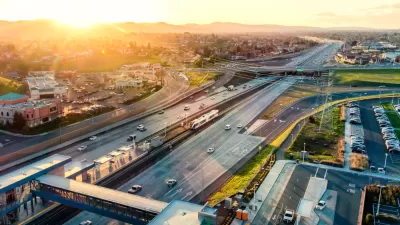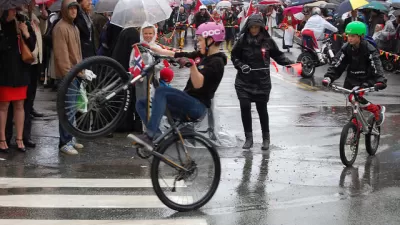My career is based, to a large degree, on my master’s thesis, which was a comprehensive evaluation of the full costs of various forms of transport. This provides a framework for determining optimal pricing, calculating the benefits of mode shifting and demand management strategies, and for comprehensive analysis of policy and planning decisions.
My career is based, to a large degree, on my master's thesis, which was a comprehensive evaluation of the full costs of various forms of transport. This provides a framework for determining optimal pricing, calculating the benefits of mode shifting and demand management strategies, and for comprehensive analysis of policy and planning decisions. In the fifteen years since this thesis was completed I expanded and updated it as new information becomes available, in a report called Transportation Cost and Benefit Analysis, available free on the Victoria Transport Policy Institute website.
This is not entirely unique; some previous studies tried to define and quantify various transportation costs (as summarized in Chapter 2 of my report), but my framework is the most comprehensive because it include categories of social and economic impacts that most economists dismiss as intangibles, such as the external costs of petroleum consumption, the value of transport system diversity (and therefore imporved mobility options for non-drivers), and the costs of land use sprawl. As a result, my work is sometimes criticized for including "excessive" costs.
Critics sometimes argue that analysis of costs ignores the significant benefits provided by transportation, but they are wrong. Yes, transport provides significant benefits (as discussed in Chapter 7 of my report), but these benefits are generally quantified based on cost reductions. For example, roadway improvement benefits are generally measured based on reductions in travel time and vehicle operating costs. Measuring costs is therefore the starting point for measuring benefits.
In recent years some often-overlooked cost categories have started to receive increasing recognition by other transportation professionals, under the concepts of sustainability and livability. For example, the USDOT has joined with the departments of Housing and Urban Development (HUD) and the Environmental Protection Agency (EPA) to support a Livability Initiative. This means that transport policy and planning decisions should incorporate the following objectives:
- Improve transportation options (i.e., help create more diversified, less automobile-dependent transport systems)
- Expand access to affordable-accessible housing.
- Enhance economic competitiveness- improve workers' access to jobs, education and services, and businesses' access to markets.
- Support community revitalization and rural landscape protection.
- Improve cooperation among federal, state, and local governments to improve transport planning and investment practices.
- Value the unique qualities of all communities.
Most transportation professionals are unprepared to deal with these objectives. Conventional transport project evaluation models only consider a small set of impacts: travel time savings, vehicle operating cost savings, and sometimes reductions in accident and emission rates per vehicle-mile. Other economic, social and environmental impacts tend to be ignored and undervalued, including the incremental costs that result from roadway expansions and fuel efficiency standards that induce additional vehicle travel. More comprehensive analysis is needed to incorporate sustainabilty and livability objectives into transport planning.

Conventional transport project evaluation generally considers roadway costs, travel time, vehicle operating costs, and some accident and air pollution costs. Other impacts are often overlooked.
Two weeks ago the US Department of Transportation, Benefit/Cost Analysis for Transportation Infrastructure: A Practitioners Workshop, at which I presented information on practical ways to incorporate livability objectives into transport decision-making. Similarly, last week I gave a presentation on methods for evaluating sustainable transport policies and investments at a major Asia Development Bank conference, Changing Course: Pathways to Sustainable Transport, and next week I'll be presenting similar information at a Transportation Research Board Energy and Environment Conference in Raleigh, North Carolina, which is timely since the theme for the 2011 Transportation Research Board Annual Meeting is Transportation, Livability, and Economic Development in a Changing World. These and many other examples indicate growing interest in sustainable transport and livable community planning. Fortunately, methods do exist for evaluating many of these objectives (transport diversity, equity, affordability, land use impacts, health impacts, affordable-accessible housing, etc.) but they are not widely known by practitioners.
The next century will require new approaches to transport planning in order to respond to changing consumer demands; it will require planning that considers a broader set of objectives, impacts and options. Planners interested in these issues will find plenty of opportunities for research and policy innovations which respond to demands for more sustainable transport systems and more livable communities.

Planetizen Federal Action Tracker
A weekly monitor of how Trump’s orders and actions are impacting planners and planning in America.

Maui's Vacation Rental Debate Turns Ugly
Verbal attacks, misinformation campaigns and fistfights plague a high-stakes debate to convert thousands of vacation rentals into long-term housing.

Restaurant Patios Were a Pandemic Win — Why Were They so Hard to Keep?
Social distancing requirements and changes in travel patterns prompted cities to pilot new uses for street and sidewalk space. Then it got complicated.

In California Battle of Housing vs. Environment, Housing Just Won
A new state law significantly limits the power of CEQA, an environmental review law that served as a powerful tool for blocking new development.

Boulder Eliminates Parking Minimums Citywide
Officials estimate the cost of building a single underground parking space at up to $100,000.

Orange County, Florida Adopts Largest US “Sprawl Repair” Code
The ‘Orange Code’ seeks to rectify decades of sprawl-inducing, car-oriented development.
Urban Design for Planners 1: Software Tools
This six-course series explores essential urban design concepts using open source software and equips planners with the tools they need to participate fully in the urban design process.
Planning for Universal Design
Learn the tools for implementing Universal Design in planning regulations.
Heyer Gruel & Associates PA
JM Goldson LLC
Custer County Colorado
City of Camden Redevelopment Agency
City of Astoria
Transportation Research & Education Center (TREC) at Portland State University
Jefferson Parish Government
Camden Redevelopment Agency
City of Claremont






























